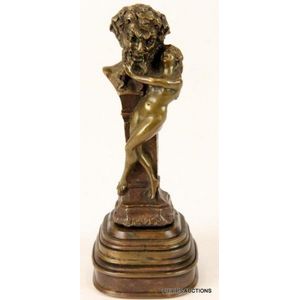French Bronze Satyr Bust on Pedestal with Nymph
A French bronze seal bust of satyr on base, circa 1900, the patinated bronze bust of satyr raised on a tall tapering pedestal, a nymph wrapped around his neck embracing him adoringly, seated on rounded square stepped base, the seal uncut, incised 'Falguiere' to the back. Height 13 cm
You must be a subscriber, and be logged in to view price and dealer details.
Subscribe Now to view actual auction price for this item
When you subscribe, you have the option of setting the currency in which to display prices to $Au, $US, $NZ or Stg.
This item has been sold, and the description, image and price are for reference purposes only.
- Incised - A record of a name, date or inscription, or a decoration scratched into a surface, usually of a glass or ceramic item with a blunt instrument to make a coarse indentation. Compare with engraving where the surface is cut with a sharp instrument such as a metal needle or rotating tool to achieve a fine indentation.
- Circa - A Latin term meaning 'about', often used in the antique trade to give an approximate date for the piece, usually considered to be five years on either side of the circa year. Thus, circa 1900 means the piece was made about 1900, probably between 1895 and 1905. The expression is sometimes abbreviated to c.1900.
- Bronze - An alloy of copper and tin, traditionally in the proportions of about 9 parts of copper to 1 part of tin.
The discovery of bronze in Western Asia in the 4th century enabled people to create metal objects which were superior to those previoulsy possible because of its strength and hardness, and it has been used throughout the world for weapons, coins, tools, statuary and other decorative items.
It is very fluid in a molten state, and its hardness, strength when set, and non-corrosive properties makes it most suitable for casting sculpture. - Satyr - A creature from Greek mythology with goat-like features, including a bearded face and horns, a man's torso, hairy legs and cloven hooves and a tail. As attendants of Bacchus, satyrs sometimes carry grapes or pitchers of wine. As spitis of fertility they may carry a cornucopia or basket of fruit.
They are also used to portray lust, and are often depicted with a leering expression. As well as being depicted singly or in a group in sculpture and candelabra, they also appear as motifs on ceramics, glass, silver and gold objects.
This item has been included into following indexes:
